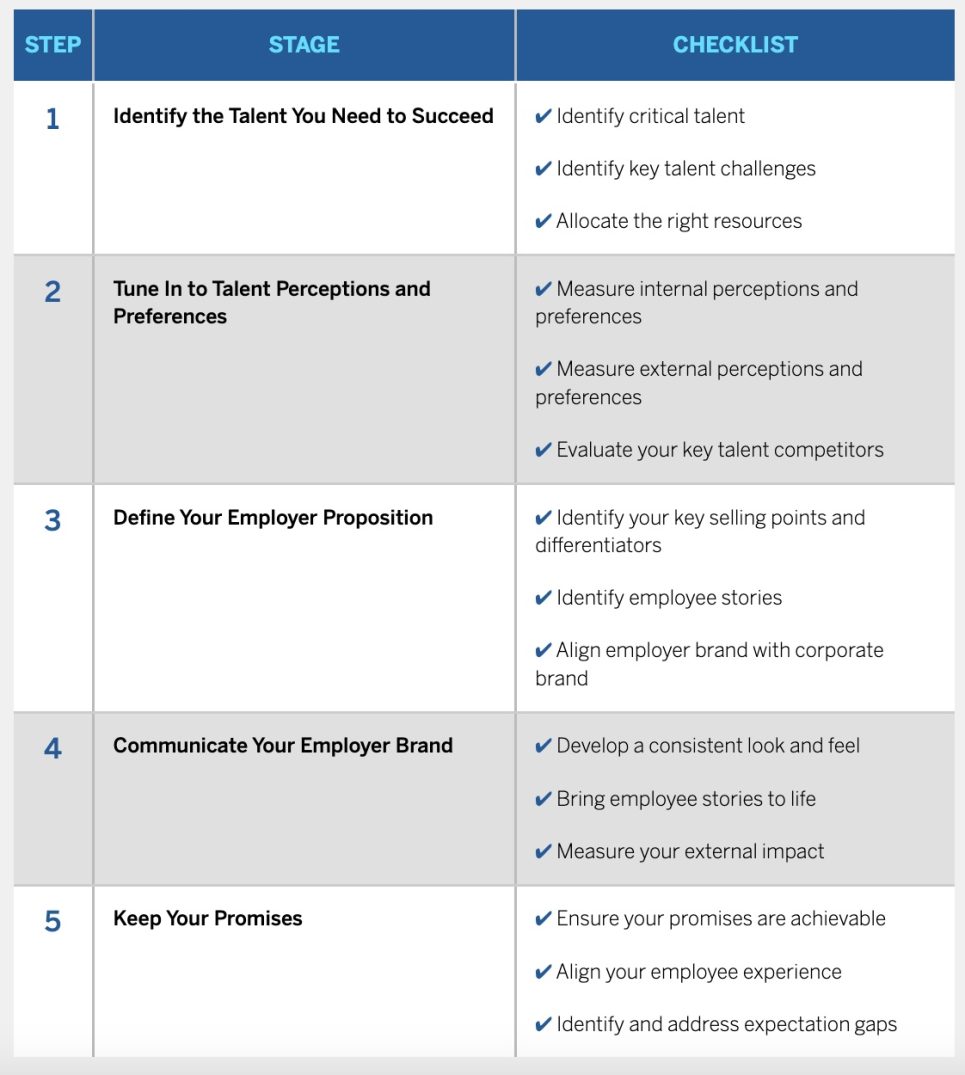A Five-Step Guide to Improving Your Employer Brand
Burnish your brand to meet the challenge of talent acquisition by taking some cues from consumer branding.
News
- Gulf Nations Fast-Track AI Ambitions, UAE Leads Regional Readiness, says BCG Report
- AI Professionals form a Redefined Workforce. But Systemic Roadblocks Persist, Survey Finds
- AI-Driven Scams Surge as Microsoft Blocks $4 Billion in Fraud Attempts
- Identity-based Attacks Account for 60% of Leading Cyber Threats, Report Finds
- CERN and Pure Storage Partner to Power Data Innovation in High-Energy Physics
- CyberArk Launches New Machine Identity Security Platform to Protect Cloud Workloads

Carolyn Geason-Beissel/MIT SMR
A consistent priority issue for boards of directors and CEOs is the acquisition and retention of talent. In a 2023 Manpower study of more than 30,000 employers in 41 countries, 75% of employers indicated that they were struggling to acquire the talent they needed. Many companies view the hiring process as the need to search for and find the right person — it is about “acquiring talent,” after all. But talent acquisition involves more than matching the right person to the right role. It also involves positioning your company as the best choice among the employers you are competing against — which highlights the importance of developing an employer brand that candidates believe will fulfill their needs and aspirations better than any other option in the marketplace.
Employer branding, or the perceptions held by internal and external constituents regarding the attractiveness of working for a company, is similar to that of consumer branding — but without the equivalent depth of interest and research. Although companies invest significant resources developing consumer brands, few focus as rigorously or commit the resources required to develop their employer brand, even though attracting talent is a top priority for CEOs. Employer branding requires a more extensive value proposition and communication plan than many traditional, lower-involvement consumer brand efforts. That is why some of the professional services and B2B companies that might not have reputations as strong general marketing firms (such as EY, Deloitte, and Siemens) are rated as having strong employer brands. In other words, organizations that are perceived to have an exceptional consumer brand-building capability are not necessarily perceived as having developed the same level of employer brand-building capability (and vice versa): Excellence on one side does not necessarily translate to excellence on the other.
The emphasis in employer branding has been on selling the company — essentially, presenting it in the best possible light. However, this element should be near the end of a multistep process. Importantly, for companies that are used to a “30-second engagement” model of consumer branding, employer branding can be daunting because it requires a candidate journey that may take weeks or potentially months of engagement, and an employee journey lasting many years.
Like great consumer marketing, effective employer branding requires deeper insight on candidate and employer needs alike, combining market segmentation, target identification, talent research, and proposition development, as well as a well-crafted brand narrative and consistent experience. Below, we share our step-by-step process on how to develop a superior employer brand, based on the winning practices of many of the world’s leading employers. (See “Build a Better Employer Brand.”)
Build a Better Employer Brand
These five steps can help you develop stronger employer branding to better meet your talent acquisition challenges.

Step 1: Identify the Talent You Need to Succeed
Strengthening talent begins with identifying the talent needed. This process includes four key elements.
First, identify your critical talent — the talent that drives company performance. Some companies will say that they want the best of the best in every function, level, and position, but few have either the resources or the brand to achieve this. Instead, it is critical to understand which positions are most important to your organization’s overall success. Often, they’re in a functional epicenter that is essential to organizational performance. For consumer packaged goods companies, this might be their brand function. For some banks, this might be their investment bankers. And for some technology companies, this might be their software engineers. These are the critical positions and functions where hiring the best must be a priority.
Second, identify the key talent challenges or the jobs where attracting or retaining employees is hardest. These must also be prioritized because they’re difficult to fill and therefore may require unique resources, attention, or approaches.
Third, analyze the profiles of your best employees and identify the distinctive factors that drive their performance and satisfaction. For example, in some roles, attention to detail may be a factor that a company’s best employees share. In others, it may be the ability to find solutions in a highly bureaucratic environment where there is tremendous resistance. These are very different skill sets. Understanding what factors enable success in a particular environment makes it easier for a company to search for candidates that are more likely to succeed there.
Finally, integrate insights about the priority roles, talent challenges, and attributes that drive employee success into a plan that prioritizes resources and talent acquisition to support company success. Without insight into mission-critical and business-strengthening talent requirements, leaders often fail to effectively allocate resources toward the talent that matters most.
Step 2: Tune In to Talent Preferences and Perceptions
Do you deeply understand the talent you need to attract and retain? What motivates them? What are their most significant needs and aspirations? And, critically, do their needs align with the benefits that candidates perceive that you provide as a current or potential employer? For a data-based understanding of the primary drivers and motivators for your target employees — which will likely vary by role, level, and other factors — tap three key sources of information.
First, conduct an internal survey to determine your current employee experience. What are the main drivers of employee engagement and advocacy? And what are the current potential sources of disengagement and unwanted attrition? Ideally, supplement these findings with deeper focus-group explorations of these questions among the talent segments you’ve identified as critical to business success.
Second, understand how you are perceived externally among important target groups. How well are you known? Among those familiar with your organization, how is your company perceived in terms of the primary drivers of engagement and attraction? There very well could be a relevant difference between employees and prospects. For example, leading investment banks like JPMorgan are generally very well known and well regarded among business students as attractive destinations for investment banking roles, but the same employers are less well known and regarded among IT students and software developers even though they represent a critical talent segment for banks. The main attraction drivers for this group are also different from those considering a career in investment banking.
Third, develop a clear understanding of who and what you’re competing against. Which employers do your most important target groups regard as ideal, and how does your company compare on the primary dimensions driving their preferences? This will include some of the leading players in your industry, but it is also likely to include businesses from other sectors on the basis of their company and employer brand reputations. In this context, what is your competition kryptonite — that is, the factors behind your company’s talent acquisition and retention issues? Often, we find that companies tend to write these issues off as if they can’t be addressed — but in a battle for talent, you can’t do that. Faced with the same challenge on a product you were selling, would you ignore the barrier that was preventing your company from landing customers? No, you would find a way to address it — either by changing the product or helping the prospect understand the value you provide.
For investment banks, as for many other industries, the competition for IT talent transcends industries. Given the significant appeal of mainstream tech-sector players to this target group, the employment deals and workplace culture offered by employers like Google, Microsoft, and Amazon need to be taken into consideration when designing an employer brand that can compete for this talent.
This is a step that many companies skip. But unless you pinpoint areas of strength and weakness in relation to your competition, you are likely to miss some of the primary factors you need to focus on to win the talent you need most.
Step 3: Define Your Employer Proposition
This is one area with which most companies are familiar: What do you need and want your employer brand to stand for in the minds of your primary target audiences? What is the unique central proposition and supporting package of distinctive qualities that will enable you to compete more effectively for the loyalty and attention of current employees and potential prospects?
The strongest propositions tend to have three main features. First, they are focused on a small number of defining qualities and benefits. While it is tempting to cover every possible attribute, this seldom results in a clear and distinctive brand image. The more you pack into your proposition, the more likely it is to blend into the background. Most leading employers combine a single-minded core proposition — the one thing they most want to be famous for as an employer — with three to four supporting pillars or themes that clarify what makes them different and special in relation to other competing employers.
For example, Laura Mattimore, head of global talent acquisition at Procter & Gamble, indicated that the company’s employer proposition focuses on its uniquely strong build-from-within approach to talent development. In its employer brand communication, P&G highlights the distinctive emphasis it places on giving new recruits significant responsibility: “You will lead from day 1.” This combination of superior talent development and significant immediate responsibility positions its employer brand well for the talent it aspires to attract and retain.
Second, strong propositions strike a healthy balance between qualities that are widely perceived to be true internally and more aspirational qualities that the leadership team is committed to improving. What must be avoided are “shop window” claims that will attract but almost immediately disengage talent when they realize the claims bear no resemblance to reality.
Finally, it’s important to maintain a degree of alignment between your employer brand and your corporate brand. While the way in which consumers experience your brand differs in kind from the employee experience, the same brand values and personality should ultimately shine through.
Coca-Cola’s approach highlights the way in which talent engagement and consumer engagement are aligned to a common brand strategy and purpose: ensuring a consistent brand experience. The purpose that is communicated to all audiences — consumers, employees, and job candidates — is “to refresh the world and make a difference,” which encompasses three pillars: “loved brands, done sustainably, for a better shared future.” Each thread of this vision and purpose is communicated a bit differently to each audience. To consumers, it’s a loved brand that they can enjoy, knowing it’s coming from a company that cares about their environment and community. For employees and job candidates, it’s the skills, growth behaviors (inclusion, curiosity, empowerment, agility), and leadership it takes to achieve Coca-Cola’s vision and mission, coupled with the value they receive as employees of Coca-Cola.
Step 4: Communicate Your Employer Brand
The next step is communicating your employer brand story effectively to your target audiences. Note three key considerations.
First, while defining your employer proposition will help to clarify what you want to communicate (the “deal”), you also need to establish how you need to communicate (the “feel”). This starts with defining the key phrases, visual design, and imagery you will use to frame your employer brand communication and ensure that it stands out from the crowd.
Danone, for example, uses a digital employer brand portal containing a range of globally consistent communication templates featuring the same design style and core brand message — “One Planet. One Health by You.” — but with numerous supporting images and messages to choose from that are specifically tailored to the particular location and target audience. As Koos Wurzer, global director of talent acquisition and employer branding at Danone, told us, “For any global employer brand, it’s vital that it’s globally consistent but locally relevant for it to be successfully deployed and have local impact.”
Second, you need to decide who is best placed to deliver your employer brand story. Increasingly, the answer to this question is not the recruitment advertising team but your employees. Research suggests that employees’ inside stories are more likely to engage and convince your target talent audiences than advertising messaging.
Some companies prevent their best salespeople — satisfied employees — from engaging in the employer branding process. But the companies with stronger employer brands understand the power of testimonials from satisfied employees and use a variety of mechanisms to attract and retain talent.
Finally, how does the company plan to track, measure, and report on the impact of its communication? In immediate terms, pay attention to the effect of new employer brand messages on levels of engagement and applications. In the longer term, for larger companies with significant recruitment needs, it’s also important to track levels of employer brand awareness, consideration, and ideal preference — that is, among those who would consider your company as a potential employer, how many regard it as an ideal choice, given the right job opportunity?
Measurement should also be a dynamic process that enables continual adaptation to changing marketplace conditions, perceptions, and preferences. Many companies develop a campus presentation and repeat it year after year. In some cases, that may be OK — but it presumes that the competitive context is static, which is seldom true.
Step 5: Keep Your Promises
It’s easy to think that all you need to build your employer brand is a strong creative campaign. It’s true that a snappy tagline and attractive visuals will help get your company noticed. However, the most sought-after talent will typically look further to get a fuller picture of your organization before applying for a job or accepting an offer. They will be influenced by the content posted by your employees on your career site and social pages and, when possible, will check review sites like Glassdoor. They may also contact current or former employees they are connected with on LinkedIn. In a world where people are seldom more than two clicks from the truth, the ultimate strength of your employer brand depends on the degree to which your brand promises are consistently delivered through the employee experience. The motto should be: “Promises made. Promises kept.”
To ensure that you deliver on your employer brand promises, we suggest doing the following.
First, don’t over-promise to attract attention. At best, you will be found out before people submit their applications. At worst, they’ll join your company, leave quickly after growing dissatisfied, and tell everyone they know about it, perhaps via an alumni network or social media. Word of mouth is exceptionally powerful in employer branding. One very vocal dissatisfied summer intern can poison the next year’s class of interns. If your brand delivery is not consistent with its promise, adapt the promise or the delivery to drive alignment.
Second, apply design thinking to the employee experience. Given your current or desired employer brand promises, design your people management processes to ensure that you’re delivering against the expectations you’ve set in your employer brand communication. Ideally, this should be a dynamic approach that applies a “test, prove, and improve” mindset and continues to strengthen and differentiate your employee experience from your competitors’.
ING Bank applies just this kind of agile design methodology to continually improve its candidate and employee experience. Sander de Bruijn, the Dutch bank’s head of global employee experience, was hired to bring a fresh marketing perspective to HR. “Stop limiting your thinking in terms of policies and processes,” de Bruijn advised. “Just like you would do with your customers, ING has put a particular emphasis on the onboarding of new colleagues to ensure that the company lives up to its external brand promises through all the key touch points in the process.”
Finally, be sure to regularly measure candidate, new-hire, and employee perceptions to identify and address any significant gaps between brand expectation and experience.
The importance of employer branding is growing, but the right approach to effectively developing an employer brand remains a black box to many leaders. The five-step process we’ve shared employs successful branding principles that have been used to create compelling consumer brands. Company leaders can use it to assess, improve, design, and implement their organization’s employer brand with an employee-centric mindset that connects company actions with prospects’ and employees’ needs. This road map for a more sophisticated brand-building approach can help boards of directors and CEOs meet the challenge of talent acquisition.





